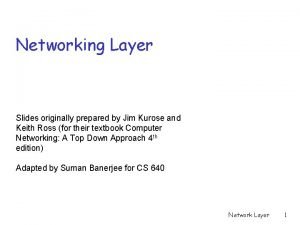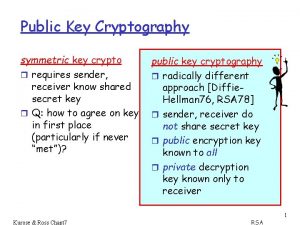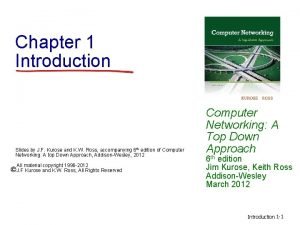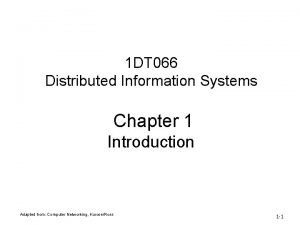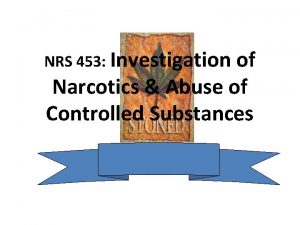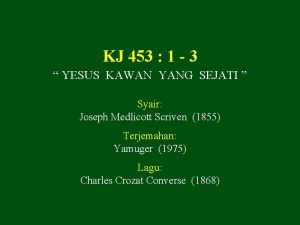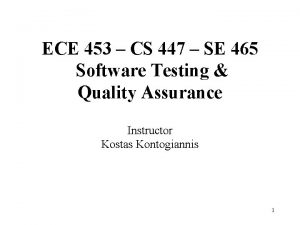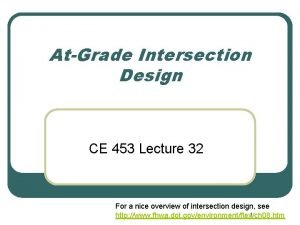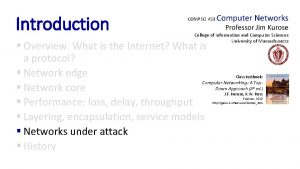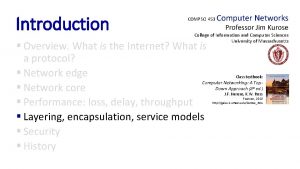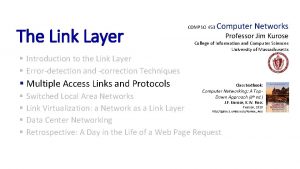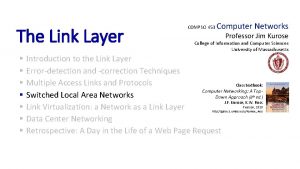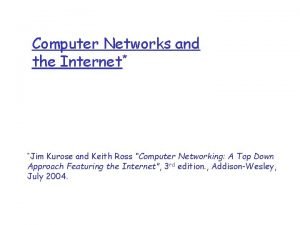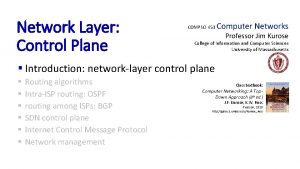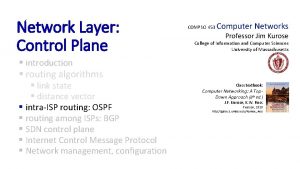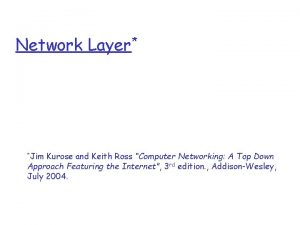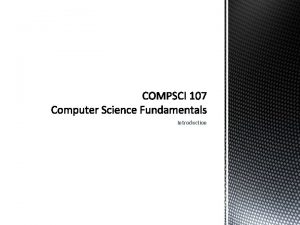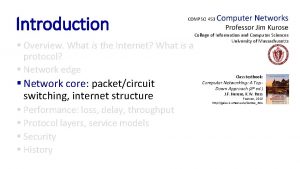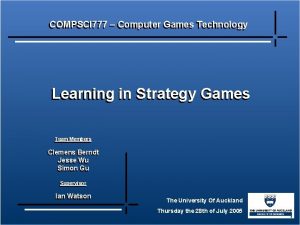Introduction COMPSCI 453 Computer Networks Professor Jim Kurose

















- Slides: 17

Introduction COMPSCI 453 Computer Networks Professor Jim Kurose College of Information and Computer Sciences University of Massachusetts § Overview. What is the Internet? What is a protocol? § Network edge § Network core § Performance: loss, delay, throughput § Protocol layers, service models § Security § History Class textbook: Computer Networking: A Top. Down Approach (8 th ed. ) J. F. Kurose, K. W. Ross Pearson, 2020 http: //gaia. cs. umass. edu/kurose_ross

A closer look at Internet structure mobile network Network edge: national or global ISP § hosts: clients and servers § servers often in data centers local or regional ISP home network enterprise network content provider network datacenter network

A closer look at Internet structure mobile network Network edge: national or global ISP § hosts: clients and servers § servers often in data centers local or regional ISP Access networks, physical media: §wired, wireless communication links home network enterprise network content provider network datacenter network

A closer look at Internet structure mobile network Network edge: national or global ISP § hosts: clients and servers § servers often in data centers local or regional ISP Access networks, physical media: §wired, wireless communication links home network Network core: § interconnected routers § network of networks enterprise network content provider network datacenter network

Access networks and physical media Q: How to connect end systems to edge router? § § § mobile network national or global ISP residential access nets institutional access networks (school, company) mobile access networks (Wi. Fi, 4 G/5 G) local or regional ISP home network enterprise network content provider network datacenter network

Access networks: cable-based access cable headend … cable splitter modem V I D E O V I D E O D A T A C O N T R O L 1 2 3 4 5 6 7 8 9 Channels frequency division multiplexing (FDM): different channels transmitted in different frequency bands

Access networks: cable-based access cable headend … cable splitter modem CMTS data, TV transmitted at different frequencies over shared cable distribution network cable modem termination system ISP § HFC: hybrid fiber coax • asymmetric: up to 40 Mbps – 1. 2 Gbs downstream transmission rate, 30 -100 Mbps upstream transmission rate § network of cable, fiber attaches homes to ISP router • homes share access network to cable headend

Access networks: digital subscriber line (DSL) central office DSL splitter modem voice, data transmitted at different frequencies over dedicated line to central office telephone network DSLAM DSL access multiplexer ISP § use existing telephone line to central office DSLAM • data over DSL phone line goes to Internet • voice over DSL phone line goes to telephone net § 24 -52 Mbps dedicated downstream transmission rate § 3. 5 -16 Mbps dedicated upstream transmission rate

Access networks: home networks Wireless and wired devices to/from headend or central office often combined in single box cable or DSL modem Wi. Fi wireless access point (54, 450 Mbps) router, firewall, NAT wired Ethernet (1 Gbps)

Wireless access networks Shared wireless access network connects end system to router § via base station aka “access point” Wireless local area networks (WLANs) § typically within or around building (~100 ft) § 802. 11 b/g/n (Wi. Fi): 11, 54, 450 Mbps transmission rate to Internet Wide-area cellular access networks § provided by mobile, cellular network operator (10’s km) § 10’s Mbps § 4 G cellular networks (5 G coming) to Internet

Access networks: enterprise networks Enterprise link to ISP (Internet) institutional router Ethernet switch institutional mail, web servers § companies, universities, etc. § mix of wired, wireless link technologies, connecting a mix of switches and routers (we’ll cover differences shortly) § Ethernet: wired access at 100 Mbps, 1 Gbps, 10 Gbps § Wi. Fi: wireless access points at 11, 54, 450 Mbps

Access networks: data center networks § high-bandwidth links (10 s to 100 s Gbps) connect hundreds to thousands of servers together, and to Internet mobile network national or global ISP local or regional ISP home network Courtesy: Massachusetts Green High Performance Computing Center (mghpcc. org) enterprise network content provider network datacenter network

Host: sends packets of data host sending function: § takes application message § breaks into smaller chunks, known as packets, of length L bits § transmits packet into access network at transmission rate R • link transmission rate, aka link capacity, aka link bandwidth packet transmission delay = time needed to transmit L-bit packet into link two packets, L bits each 2 1 host R: link transmission rate L (bits) = R (bits/sec)

Links: physical media § bit: propagates between transmitter/receiver pairs § physical link: what lies between transmitter & receiver § guided media: • signals propagate in solid media: copper, fiber, coax § unguided media: • signals propagate freely, e. g. , radio Twisted pair (TP) § two insulated copper wires • Category 5: 100 Mbps, 1 Gbps Ethernet • Category 6: 10 Gbps Ethernet

Links: physical media Coaxial cable: Fiber optic cable: § two concentric copper conductors § bidirectional § broadband: § glass fiber carrying light pulses, each pulse a bit § high-speed operation: • high-speed point-to-point transmission (10’s-100’s Gbps) § low error rate: • repeaters spaced far apart • immune to electromagnetic noise • multiple frequency channels on cable • 100’s Mbps per channel

Links: physical media Wireless radio § signal carried in various “bands” in electromagnetic spectrum § no physical “wire” § broadcast, “half-duplex” (sender to receiver) § propagation environment effects: • reflection • obstruction by objects • Interference/noise Radio link types: § Wireless LAN (Wi. Fi) • 10 -100’s Mbps; 10’s of meters § wide-area (e. g. , 4 G cellular) • 10’s Mbps over ~10 Km § Bluetooth: cable replacement • short distances, limited rates § terrestrial microwave • point-to-point; 45 Mbps channels § satellite • up to 45 Mbps per channel • 270 msec end-end delay

Introduction COMPSCI 453 Computer Networks Professor Jim Kurose College of Information and Computer Sciences University of Massachusetts § Overview. What is the Internet? What is a protocol? § Network edge § Network core § Performance: loss, delay, throughput § Protocol layers, service models § Security § History Class textbook: Computer Networking: A Top. Down Approach (8 th ed. ) J. F. Kurose, K. W. Ross Pearson, 2020 http: //gaia. cs. umass. edu/kurose_ross Video: 2020, J. F. Kurose, All Rights Reserved Powerpoint: 1996 -2020, J. F. Kurose, K. W. Ross, All Rights Reserved




